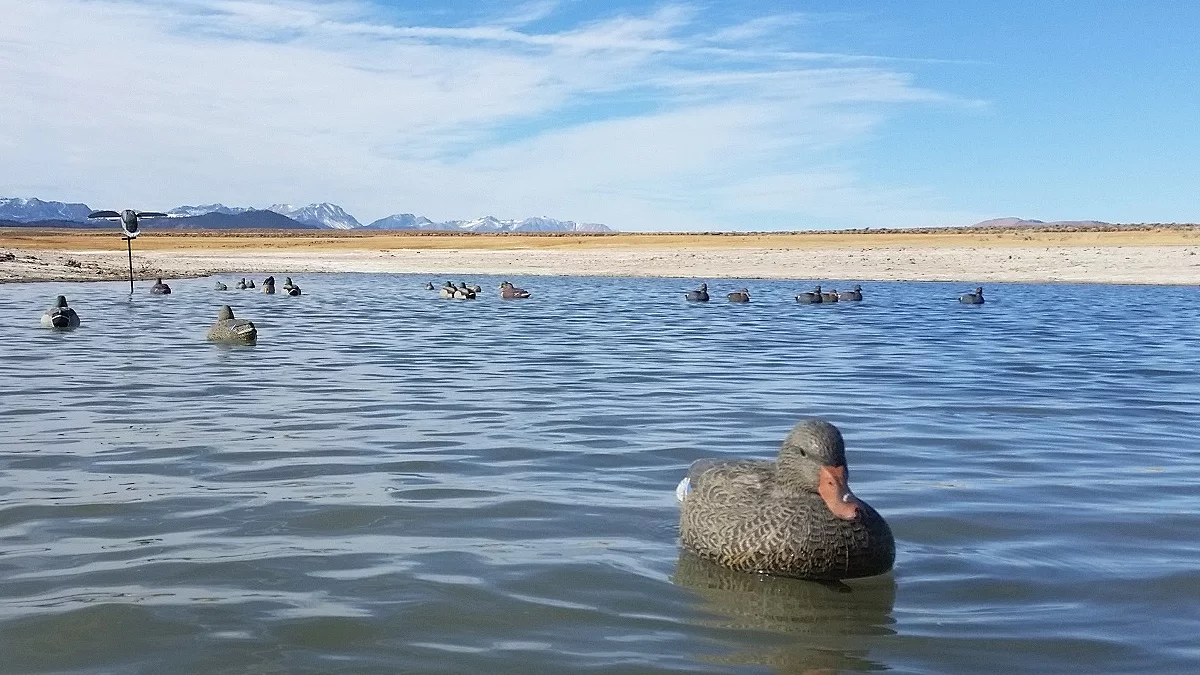
Decoying
You can decoy, jump shoot, or set up in a spot to shoot pass over ducks on approach to or take off from water holes, but if you are going to decoy its important to know some decoy basics. I’ll briefly touch on quantity, species, sizes, types, materials, and rigging.
Decoy Quantity
Well equipped waterfowlers may deploy hundreds of decoys. However, for the waterfowler just starting out, or on a tighter budget, its reasonable to start with as little as one dozen. The more the merrier, but don’t be discouraged if you have to start out small.
Decoy Species
You can’t expect to have a few dozen of every duck or goose species on day 1 of your waterfowl hunting career. Fortunately, Mallard decoys also draw Gadwalls, Pintails, Teal, Widgeons and other dabbling or ‘puddle’ ducks. Setting out a spread of Mallards, and nothing else is an easy way to attract a few species, not just Mallards.
Decoy Sizes
Decoys are available in a range of sizes from 3/4, Standard, to Full Size, Magnum, Super Magnum, and Battleship, or other extra large sizes and brand specific variants all over. It’s not the size of the decoy, its how you use it! This is actually only mostly true with decoys. Size sometimes matter. The purpose of a decoy spread of course is to attract birds. So in small spaces that you know there are birds, small decoys are easily visible. In large and open spaces, although all decoy sizes can work, larger ones will be seen at a greater distance, giving an edge to a decoy spread set far away from bird traffic with bigger decoys.
Decoy Types
Some decoys are meant for ponds, others for dry fields or flooded fields. As such they come in a variety of types from Full Body, to Profile, Floaters, Shells, and Wind Socks. For a pond or open water, you’ll need floaters, in shallow water, banks, or areas both wet and dry, a variety of decoys can be used.
- Full Body decoys are often staked, to look like a standing bird on dry or mostly dry ground.
- Shells are exactly what they sound like, usually only showing the top half of a body, and set out on the ground.
- Profiles AKA 2D or Silhouette decoys, are flat profiles of birds meant to stake into the ground, and don’t take much space. However, like anything 2D, they are not visible from a perpendicular angle, and require a strategic placement, to attract nearby birds.
- Wind Socks, are a hollow ‘full body soft shell’ meant to stake into the ground. They are similar in effect to full body shells, but can be packed up to take less room.
- Floaters are the normal start for any kind of pond or over water shooting, and although I’ve covered a variety of decoys types and uses, chasing after puddle or dabbling ducks is a minor focus of this article. With that said, floaters float. Modern floating decoys differ mostly in material, whether they are foam filled or hollow, and whether they have a weighted keel, or the keel fills with water to keep them positioned upright.
Decoy Materials
Modern floaters are usually hollow plastic, are fairly lightweight and tough, but can be somewhat expensive. Aged or damaged hollow plastic decoys can leak, and fail to float. Some decoys are filled with foam, so that they won’t fail to float. Other Plastics, Urethanes, Wood, and fabrics are used for decoys. Some DIY profiles are nothing more than yard signs.
Decoy Rigging and Weights
Rigging can make managing of decoys a nightmare or a breeze. Tangles can ruin your day, and a low quality or poorly rigged setup might not keep your decoy spread where you’d like. I mostly hunt shallow waters, and a 36″ or 48″ Texas rig works great. A 12 pack of Texas-Rig weights starts out around 30 dollars, adding to your startup costs but eliminates the hassle of buying bulk amounts of equipment and tools to rig your own. Its well worth the investment, for hassle free and tangle free decoy management.
Recommendations:
Hard Core 36 inch Texas-Rig with 4oz. Weights
Hard Core Brands Mallard Dscoys (12 Pack)
Higdon Outdoors Standard Mallard Decoys (6 Pack)
AvianX Top Flight Duck Back Water Mallard Decoy (6 Pack)
What are we talking about here? Ducks.org has a great resource for identifying migratory bird species.
http://www.ducks.org/hunting/waterfowl-id/


Leave a Reply